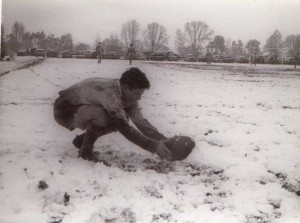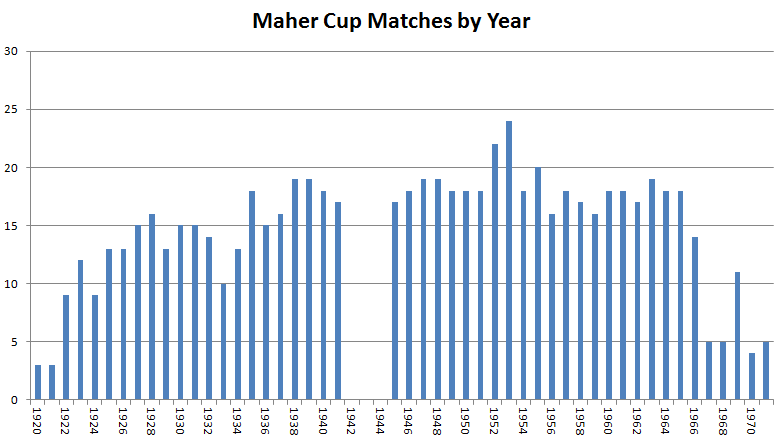After some forty-five years, interest in the Maher Cup was beginning to wane by 1965, but at Tumut on the 7th of August a deep covering of snow didn’t deter some 500 diehards from driving out to the Racecourse ground for another gruelling encounter. Continue reading
Category Archives: Matches
Gibsonvale 1946: Phil’s Truck & the Trip to Tumut
Gibsonvale was perhaps the Maher Cup’s most unlikely contender. These days, on Google Earth only ribbons of white mine scars remain. Gone are the hessian and corrugated iron huts built by battlers and fortune-hunters along the stockroute. Gone is the post office, the store, the school and the unfenced football field. Stoneham’s billiards hall and the Kikoira Pub remain, abandoned. Continue reading
All Maher Cup Winners 1920-1971
Below is a chart showing the winner of each Maher Cup match through time. Where there was a draw it has been coded for the holder.
The colours have been selected to best represent the team colours. While I’m confident that teams colours have been pretty constant for Tumut, Gundagai, Cootamundra, Temora, West Wyalong and Young, others have not been. If you have further information about when and how team colours changed I would be most interested. Continue reading
Temora v West Wyalong ad infinitum 1933
Games That Changed The Game No.4
People often tell me that things were simpler in the old days. Less red tape. We just got on with it lad. Hmmm but not aways. In Maher Cup Country, when footballing matters mattered things could get quite bogged down. People could be a little pernickety.
In deep Depression days, in 1932, Temora paid for a new captain coach – twenty-five year old Harry Thompson. He was a useful half-back from Brisbane, a Queensland representative. He became the other half to Eric Weissel, who now at 29, and at the very top of his game, was the chief draw-card in Group 9. Continue reading
Young v Grenfell 9 August 1939
Games That Changed the Game No.3
The Grenfell Greens had not achieved much in Maher Cup football. Until 1938 their challenges had been limited to just four – all lost, with just 13 points earned and 80 conceded.
However by the late thirties the best teams – Young, West Wyalong, Temora and Cowra. were from the northern part of Maher Cup country. Grenfell was keen to get into action against its traditional rivals. Not having enough local talent they decided to go and buy a team. Continue reading
The Biggest Maher Cup Matches
Which games attracted the biggest crowds? Let’s make a top ten list.
Unfortunately this is quite difficult. My memory of rolling up to a Maher Cup match was of a ticket seller at the gate with a bookmaker’s bag taking cash and dispensing tickets. There were no turnstiles to tally the mob. Continue reading
Cootamundra v Canowindra 29 August 1928
Games that Changed the Game No.2
Roddy Gilmore, farmer of Canowindra, was a pretty useful second rower. He worked a 600 acre soldier settler’s block, carved from the North Bangaroo Estate in 1924. It was said that he “cut off the legs of his working trousers to make his football shorts for his first game (Worboys, p22).
On Wednesday 29 August 1928 he played for the Maher Cup against the champions of the south, Cootamundra. Continue reading
Cootamundra v Tumut 6 June 1923
Games That Changed The Game No. 1
This is the first in a series.
“And the rain it gently, pattered down! And the lovely green flats of the ‘Bidgiee silhoutted, as it were, against the sky line as the special train from Tumut, with footballers and supporters aboard steamed over the railway bridge yesterday afternoon. The footballers’ quest was the Maher Cup — they were going to capture it for Tumut— so they said. And their supporters were going to stir them on to deeds of derring do”.
(The Gundagai Independent, 7 June 1923).
Background
Let us step back from the poetry. It was a Wednesday afternoon – the 16th challenge for the Maher Cup was set to be played at Fisher Park Cootamundra. It was less than three years since Ted Maher put the Cup into play. Things were starting to get very serious. The rules were read scrupulously, and Rule 9 was a problem. Continue reading
Maher Cup Games By Year
The cup season generally involved about 15-19 matches. 1953 with 24 games had the busiest schedule. Continue reading
Cootamundra The Dominant Team
Although Tumut is both the place of origin and place of rest for the Cup, Cootamundra was the heart of Maher Cup football. As you can see below Cootamundra was clearly the dominant side. It was also the geographical and administrative centre of Maher Cup and Group 9 Football.
There were in my calculation 729 challenges between 1920 and 1971 for the Maher Cup. Continue reading

